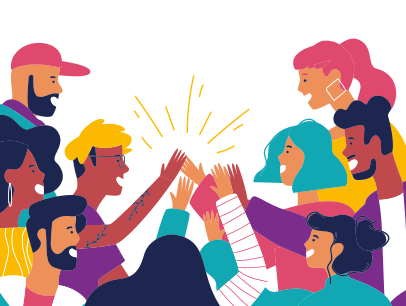
Two of the most beloved comedies in television history in the United States have been the 1970s series The Mary Tyler Moore Show and M*A*S*H. It may seem that these long-running shows could not have been more different. The first took place at a small American TV station in the present day. The second was set in and around a mobile army surgical hospital in South Korea in the early 1950s. What could they possibly have in common?
In short, they shared the same element that TV hits like The Office and Abbott Elementary do: They centered around workplace families. The characters spent far more time with their coworkers than with their loved ones. That doesn’t mean they always got along—any more than any family does. But they really mattered to each other.
The fact that these shows were so beloved reflects the importance of our own friendships in the workplace. The relationships that we form on the job can make all the difference. According to a report from Gallup, the average employee spends the equivalent of nine years at work. That means that without office friends, we social beings would be a lot lonelier. In fact, in his book Blind Spot: The Global Rise of Unhappiness and How Leaders Missed It, Gallup CEO Jon Clifton says two in 10 workers in the U.S. report spending large portions of their day feeling lonely. In the U.K., a recent study noted that 9 million adults, well over 10% of the population, are often or always lonely, leading to a “loneliness epidemic.”
“Work is one of the most important opportunities to find friends, build bonds, and enhance interactions [that] contribute to your fulfillment,” says sociologist Tracy Brower, author of The Secrets to Happiness at Work. Friendships at work help alleviate burnout and stress. They are so important to employees, according to a survey from BetterUp, that half of us would even give up a raise or promotion if it meant stronger relationships with colleagues.
Office friendships are also beneficial for the company. As good managers know, friendships can contribute to the bottom line because they make us eager to get to work. They boost morale. They promote collaboration and trust, as well as both personal and professional growth. They provide a support system to employees that extends beyond the workplace, so people are less likely to need days off for physical or emotional reasons. (Office friendships also serve as a great network for getting other jobs, but don’t tell the boss!) Best of all, says BetterUp, it only takes five to seven good relationships at the office to benefit. We’re not talking best friends, mind you. Just people we can talk to, share a joke with, or get a cup of coffee with.
“Work is one of the most important opportunities to find friends, build bonds, and enhance interactions [that] contribute to your fulfillment.”
Tracy BrowerHow to Make Friends at Work
So, if workplace friendships are good for us and our companies, how do we go about creating them? It’s a lot like making friends anywhere, notes Inna Utsekha, a human resources business partner at Wilshire, based in London. “Building friendships at work involves engaging in conversations,” she says, “as well as participating in social interactions, offering help, showing genuine interest, remaining approachable, discovering shared interests, practicing active listening, upholding professional boundaries, and allowing friendships to develop gradually.” Maybe you want to volunteer for an assignment, or simply bring in doughnuts for the team. Try complimenting someone—as long as you’re not being too personal. Loosen up a little and see what happens.
There are four types of friendships that your relationship with a colleague could turn into: acquaintance, casual, close, and lifelong. While a coworker might start off as an acquaintance (someone you have met, but do not know on a personal level), they can become a casual friend (someone you interact with frequently, often due to a shared environment, like the workplace), or even a close friend once you know them on a deeper level. Research indicates that it takes two people about 90 hours together to become friends if they are both willing, and 200 hours to become close friends. With a typical 40-hour work week, that’s very doable.
Try not to stress too much about it, however. “Research shows that people are more apt to like you if they have the impression that you actually like them,” adds social psychologist Angelika Kofler, a consultant on organizational development in Vienna, Austria.
As for business leaders, says Clifton, they can help employees grow friendships by promoting face-to-face conversations and teamwork, and even updating the configuration of the workplace to encourage interaction. They can also foster lunchtime or after-hours shared interest groups, such as a choir or exercise class. Or maybe a corporate Toastmasters club!

The Downside to Office Friendships
Although office friendships have many benefits, there is a potential drawback to work relationships. We’ve all known employees who appear to get special treatment, and this is especially problematic when they’re friends with the boss or a direct supervisor.
“Potential challenges with friendships at work include perceptions of favoritism, conflicts of interest, and interpersonal conflicts,” explains Utsekha. Think about it: What if you hurt your friend’s feelings by passing them over for a special project in order to help out someone else? To address these issues, she says, it’s important to ensure fairness and transparency in all interactions, as well as to establish clear boundaries between the personal and professional, to address conflicts promptly and constructively, and above all, to prioritize work responsibilities.
Employees who also interact with others frequently, such as those who congregate at the watercooler Monday mornings to discuss their weekends, are, in effect, stealing time from the company. So are those who have such a good time at lunch, they forget that their hour is over. Or people who go down the rabbit hole of amusing interoffice emails. It’s important to remember that work is—well, work.
Putting It All Together
Like most things in life, office friendships have their pros and cons. In this case, the benefits are so plentiful for both employees and their companies—and don’t forget clients who deal with happy workers—that most business experts agree that these relationships are well worth the effort.
Incidentally, the same can be said for friendships in Toastmasters. We can build positive relationships by introducing ourselves to new members, offering to mentor a fellow member, and accepting invitations for out-of-club events. These friendships can be golden, enhancing our experience in a thousand ways, including providing motivation to reach our personal goals in and outside of the club meetings, and offering just plain fun.
Although we are off the clock—even in a corporate club—we should still behave professionally, which means fairly and transparently, to fellow officers and club members. It isn’t always easy. But like any other skill we pick up as budding leaders and speakers, it will serve us well for a long time to come.
Caren S. Neile, Ph.D. teaches, writes, and stockpiles social capital in Boca Raton, Florida. Visit her at carenneile.com
Related Articles

Personal Growth
Finding Friendship in Toastmasters

President's Message
Fun and Friendship in Toastmasters

Personal Growth



 Previous
Previous

 Previous Article
Previous Article